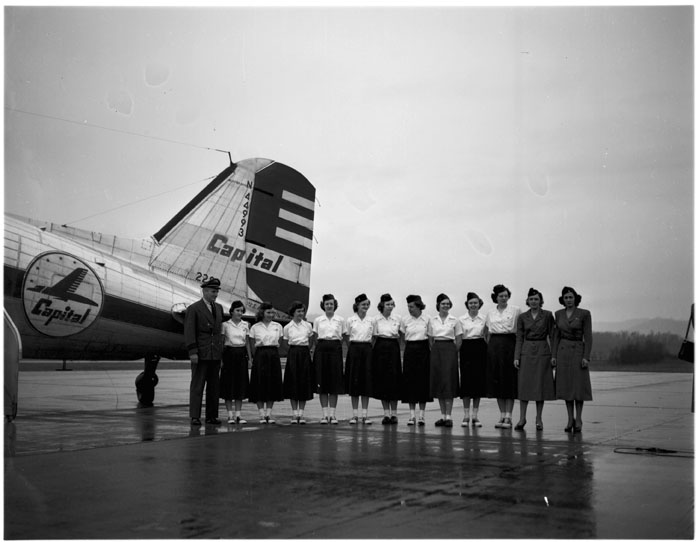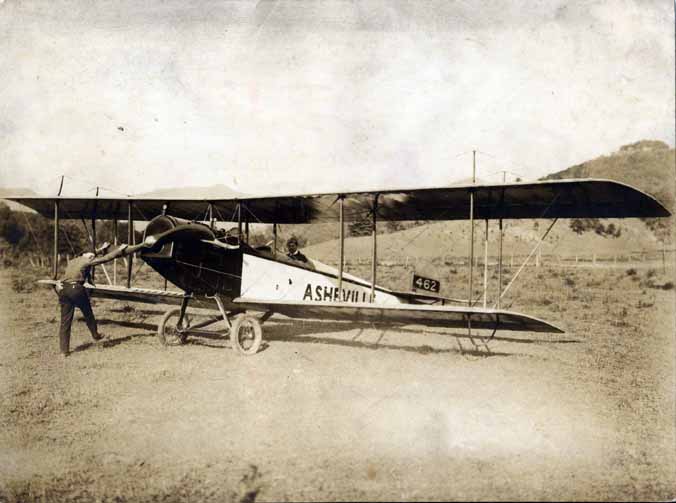On June 26, 1927, a cartoon appeared in The Sunday Citizen. In it, a single-engine airplane flies over Asheville, packed with people peering down at the city. In the rear of the plane stands a man with a megaphone. He declares:
“Ladies and gentlemen, we are now passing over the beautiful city of Asheville, nestled in the mountains of Western N.C. I regret that we cannot land at this wonderful place, due to the fact that they neglected to provide an airport.”
The cartoon was in response to several months of broken promises and false starts. That previous winter, the newspaper reported that an airport was imminent. Members of both the Asheville and Hendersonville chambers of commerce had formed an aviation committee to seek out a proper location for its site. Nine tracts of land were inspected. It was predicted that the operation would be up and running by midspring.
News coverage continued throughout the period. On Feb. 6, 1927, The Sunday Citizen noted that the airplane, once viewed as “a rich man’s toy … [believed] never to be as useful as the automobile … has come to stay.” For this reason, the paper continued, “Asheville, destined as it believes to become one of the important cities of the South is taking steps to build an airport.”
By April, without a concrete plan in sight, The Asheville Citizen published a letter written by Roger Babson, an eminent statistician and economist. In it, Babson asserted that the clock was ticking. “[E]very municipality, which gives any thought to its future prosperity at all should, right now, set aside space for the construction of an airport,” he wrote.
Despite Babson’s urgent message, the committee failed to settle on a location that spring.
On July 15, The Asheville Citizen reported that Mayor Gallatin Roberts insisted the aviation committee resolve the matter without further delay. According to the article, Roberts declared:
“We ought to have the airport right now. … If we had it I haven’t a doubt in the world that Colonel Charles A. Lindbergh, the world’s greatest and most popular aviator, would come here in connection with his national tour on behalf of the development of aviation.”
Instead, the mayor continued, “[W]e are left out in the cold — because we have not kept apace with the development of aviation in the nation.”
By October, the committee was still without a decision. That month, it hosted C.I. Stanton, U.S. Bureau of Aeronautics engineer. He arrived in the mountains to survey the properties considered by the group.

Stanton told the paper that once a location was settled on, “Asheville will face unlimited opportunities.” Above all, the engineer believed an airport would help attract additional visitors to the region. According to the article, Stanton “stressed the possibilities of many tourists of the future coming through the air in their own planes just as they do by automobile on highways today[.]”
Another 10 months would pass before the committee came to a resolution.
On Aug. 11, 1928, The Asheville Citizen announced: “An airport, jointly financed by Asheville and Hendersonville capital, will be established on the old Baldwin Farm, one-half mile east of Fletcher[.]”
The yearlong wait was met by swift and decisive action. Workers, the paper continued, were already grading the field and clearing the site of tree stumps.
By month’s end, a formal celebration was held. “With more than a dozen stunt and passenger planes thundering into action before a crowd estimated at 10,000 people, the Asheville-Hendersonville airport … made its bow to the people of Western North Carolina yesterday afternoon,” the Aug. 25, edition of The Asheville Citizen read.
On Oct. 13, regular services at the Asheville-Hendersonville Airport were underway. Prices varied. Field flights cost $3; city flights ran for $5; journeys over Mount Mitchell, Chimney Rock and Asheville cost $20. Meanwhile, the paper wrote, “Cross country flights will cost 15 cents per mile per passenger.”
The airport continued operations for the next 32 years. In 1960, during its final year, it handled 24,956 passengers.
On Jan. 15, 1961, the new, present-day Asheville Airport opened. That summer, reporter Philip Clark wrote that the new operation “put the city and the surrounding mountains region squarely abreast of the modern age of air transportation.”
Editor’s note: Peculiarities of spelling and punctuation are preserved from the original documents.




Before you comment
The comments section is here to provide a platform for civil dialogue on the issues we face together as a local community. Xpress is committed to offering this platform for all voices, but when the tone of the discussion gets nasty or strays off topic, we believe many people choose not to participate. Xpress editors are determined to moderate comments to ensure a constructive interchange is maintained. All comments judged not to be in keeping with the spirit of civil discourse will be removed and repeat violators will be banned. See here for our terms of service. Thank you for being part of this effort to promote respectful discussion.